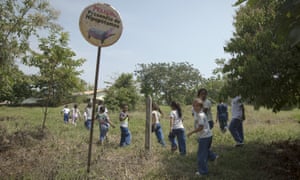When the drug lord Pablo Escobar was shot dead in 1993, he left behind a zoo stocked with wild animals alongside his multibillion dollar cocaine empire. The lions, giraffes and other exotic species were moved from the luxurious Hacienda Napoles estate east of Medellin to new homes, but nearly three decades later, dozens of hippos, descendants of animals left behind, are thriving in small lakes in northern Colombia, making them the world’s largest invasive animal.
Now scientists say that contrary to the conventional wisdom that large invasive herbivore mammals have strictly negative effects on their new environments, Escobar’s “cocaine” hippos show how introduced species can restore a lost world.
A team of conservation biologists has compared the traits and impacts on the ecosystems from large invasive herbivore species like the Colombian hippo with their extinct counterparts from the Late Pleistocene (around 116,000-12,000 years ago) period like mammoths, giants sloths and giant wombats. They found some modern day invasive species restore parts of ecosystems not seen since before humans began driving the widespread extinctions of megafauna.

Their new study, published in Proceedings of the National Academy of Sciences, found that some introduced herbivore species are an almost perfect ecological match for extinct species from the Late Pleistocene, such as modern day wild horses known as mustangs and the extinct pre-domestic horses in North America, while others bring back a mixture of traits.
“The feral hippos in South America are similar in diet and body size to extinct giant llamas, while a bizarre type of extinct mammal – a notoungulata – shares with hippos large size and semiaquatic habitats,” explained study co-author John Rowan, Darwin fellow in organismic and evolutionary biology at the University of Massachusetts Amherst.
“So, while hippos don’t perfectly replace any one extinct species, they restore parts of important ecologies across several species.”
By comparing ecological traits of herbivore species from before the Late Pleistocene extinctions to the present day, such as body size, diet and habitat, researchers were able to quantify the extent to which introduced species were more or less similar to extinct predecessors.
The analysis found that by introducing large herbivore species across the world, humans had restored lost ecological traits to many ecosystems, thereby counteracting a legacy of extinctions and making the world more like the pre-extinction late Pleistocene.

Erick Lundgren, lead author and PhD student at the University of Technology Sydney, told the Guardian: “The word ‘invasive’ doesn’t really leave any room for organisms that do something that’s beneficial for another species. ‘Invaders’ don’t really help anything. And with that kind of anthropomorphic branding, you end up with a very limited range of research questions that are usually asked.”
The researchers give the example of wild pigs, which are widely disliked by farmers across the southern United States for destroying crops when large groups are “rooting” for food. But Lundgren said the behaviour is an ecosystem service that had been performed by other large herbivores that have since become extinct.
“There are many species that did what pigs do: just turning over soil. In North America, there were these giant peccaries. There were all these species that did the same thing in the late Pleistocene. For millions of years, everything evolved with this kind of rooting behaviour,” he explained.
“If you actually look at what that rooting behaviour does, it is of course density dependent. So if you have 10bn pigs rooting over every inch of soil, there are species that are going to lose their preferred habitats, 100%. But rooting actually does some interesting things. In Tennessee, they’ve found that trees actually grow faster because of the rooting of wild boar because they’re incorporating leaf litter in the soil, increasing decomposition rates and more nutrients become available quicker for trees.”
The study authors came from the University of Technology Sydney (UTS) in Australia, the University of Kansas, the University of California Davis and the Natural History Museum of Los Angeles County in the US., Sussex University in the UK, the Universidad de Alcala in Spain and Aarhus University in Denmark.